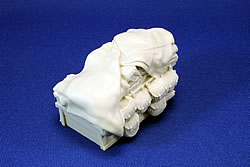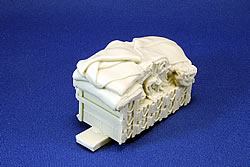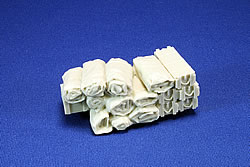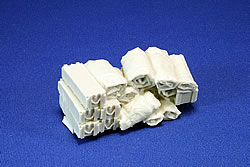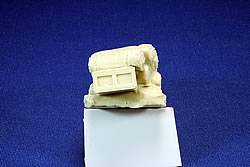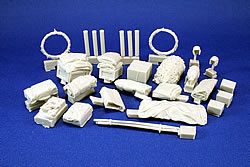|
U.S.
Priest Stowage No. 1 |
 |
|
With a crew of seven, it's not surprising that just about any photo you see of the M7 Priest shows the front and rear laden with vehicle equipment and personal gear. I'm sure it was always a bit of a trick piling those items on without blocking the air ventilation on the top deck. That concern is sometimes missed by less knowledgeable modelers. This hefty stowage set from Resicast offers enough items to outfit two Priests. Although its not noted on the packaging, it is designed for the Academy Priest, according to Graham Sellar. The gear is "anchored" by two large resin pieces festooned with sleeping bags, ammo boxes, and whatnot. However, these pieces don't take into account the gas vents and guard plates on the back deck of the early/intermediate M7 that Academy forgot to add. The block with the many ammo boxes could work on top of the early/intermediate M7 since often the crew built a "table" on top of the vents for the gear to sit on (see page 27 of Steve Zaloga's U.S. Armored Artillery in WWII book). There is already a framework around the ammo boxes so it would be a simple matter to just put a piece of plastic card underneath as the table surface.
The other large piece with fewer ammo boxes is more problematic since the bottom of the piece is angled to the slope of the deck, and the outlying box sits level atop the stowage bin. In effect, this piece negates the existence of the vents and plates. A simple adaptation would be to make a table as above and set the piece on it, with a putty tarp bunched up between the box and the stowage bin.
As I reported in the review of the Priest 105mm Ammunition, Crates, and Spent Ammo Cases, backed by Kurt Laughlin's extensive research article, the style of box depicted by Resicast is suspect, as a longer, end-opening style was used predominantly throughout the war. This shorter top-opening version, with the latches, does not appear to be a WWII version. However, it is possible, with some surgical work, to give these a more appropriate appearance. The pieces are well cast and carriers will need to be tackled with a hobby saw, but in most cases the cutting involves a quarter inch by less than a half inch of surface area and should go quickly. This is a quick way to convincingly dress up a pair of Priests, and the deficiencies of the Academy's rear deck can be rectified fairly simply. Thanks to Graham Sellar for the review sample. -tss |
 |
 |
 |
 |
 |
 |
 |
 |
 |
 |
 |
 |
|
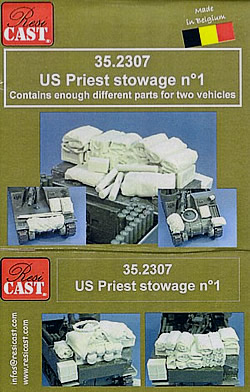 Resicast
Resicast